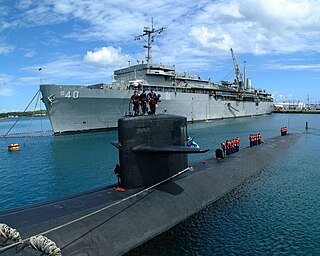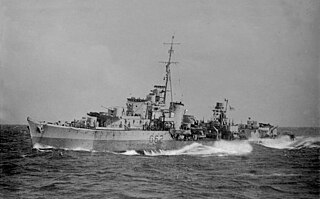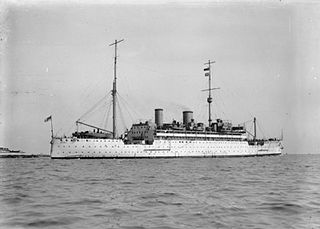
A seaplane tender is a boat or ship that supports the operation of seaplanes. Some of these vessels, known as seaplane carriers, could not only carry seaplanes but also provided all the facilities needed for their operation; these ships are regarded by some as the first aircraft carriers and appeared just before the First World War.

HMS Hero was an H-class destroyer built for the Royal Navy in the mid-1930s. During the Spanish Civil War of 1936–1939 the ship enforced the arms blockade imposed by Britain and France on both sides as part of the Mediterranean Fleet. During the first few months of World War II, Hero searched for German commerce raiders in the Atlantic Ocean and participated in the Second Battle of Narvik during the Norwegian Campaign of April–June 1940 before she was transferred to the Mediterranean Fleet in May where she escorted a number of convoys to Malta. The ship took part in the Battle of Cape Spada in July 1940, Operation Abstention in February 1941, and the evacuations of Greece and Crete in April–May 1941.

HMS Griffin (H31) was a G-class destroyer, built for the Royal Navy in the mid-1930s. In World War II she took part in the Norwegian Campaign of April–May 1940 and the Battle of Dakar in September before being transferred to the Mediterranean Fleet in November. She generally escorted larger ships of the Mediterranean Fleet as they protected convoys against attacks from the Italian Fleet. Griffin took part in the Battle of Cape Matapan in March 1941 and the evacuations of Greece and Crete in April–May 1941. In June she took part in the Syria-Lebanon Campaign and was escorting convoys and the larger ships of the Mediterranean Fleet until she was transferred to the Eastern Fleet in March 1942.

A submarine tender is a type of depot ship that supplies and supports submarines.

HMS Quality (G62/D18) was a Q-class destroyer built for the Royal Navy. Entering service in 1942, the destroyer served in several theatres of World War II. Following the war's conclusion, the ship was transferred to the Royal Australian Navy (RAN), commissioning as HMAS Quality (G62/D262) in late 1945. Unlike her sister ships, which were refitted as anti-submarine frigates, Quality was not modified, decommissioned after only 59 days of service, and was sold for scrap in 1958.

HMS Perseus was a Colossus-class light fleet aircraft carrier built for the Royal Navy during World War II. The ship was initially named HMS Edgar, but she was renamed in 1944 when the Admiralty decided to convert her into an aircraft maintenance carrier. She was completed in 1945, after the end of World War II, and she made a trip to Australia late in the year. Upon her return to the UK in early 1946, Perseus was placed in reserve. The ship was recommissioned in 1950 to serve as the trials ship for the steam catapult then under development. Over 1,600 test launches were conducted before the catapult was removed in 1952 and she was converted for use as a ferry carrier to transport aircraft, troops and equipment overseas. She was reduced to reserve again in 1954 and sold for scrap in 1958.

Swan Hunter, formerly known as Swan Hunter & Wigham Richardson, is a shipbuilding design, engineering, and management company, based in Wallsend, Tyne and Wear, England.

HMS Maidstone was a submarine depot ship of the Royal Navy. She operated in the Mediterranean Sea, Indian Ocean and Pacific Ocean during the Second World War. She was later used as a barracks ship and then a prison ship in Northern Ireland.

HMS Adventure, pennant number M23, was a minelaying cruiser of the Royal Navy built in the 1920s that saw service during the Second World War. Her commander between 1928 and 1929 was the future First Sea Lord John H. D. Cunningham.

HMS Medway was the first purpose-built submarine depot ship constructed for the Royal Navy. She was built by Vickers Armstrong at Barrow-in-Furness during the late 1920s. The ship served on the China Station before the Second World War and was transferred to Egypt in early 1940. Ordered to evacuate Alexandria in the face of the German advance after the Battle of Gazala in May 1942, Medway sailed for Lebanon at the end of June, escorted by a light cruiser and seven destroyers. Her strong escort could not protect her; on 30 June a German submarine torpedoed and sank her.

A depot ship is an auxiliary ship used as a mobile or fixed base for submarines, destroyers, minesweepers, fast attack craft, landing craft, or other small ships with similarly limited space for maintenance equipment and crew dining, berthing and relaxation. Depot ships may be identified as tenders in American English. Depot ships may be specifically designed for their purpose or be converted from another purpose.

HMS Active, the tenth Active, launched in 1929, was an A-class destroyer. She served in the Second World War, taking part in the sinking of four submarines. She was broken up in 1947.

The Xanthus-class repair ships were a class of five auxiliary ships built for the United States Navy and Royal Navy. Ships of the class served in a diverse range of environments in varying capacities during both World War II and the Korean War. Xanthus-class ships were in commission between 1945–1955.

The second HMS Vega was a V-class destroyer of the British Royal Navy that saw service in World War I and World War II.

HMS Venomous (ex-Venom), was a Modified W-class destroyer of the British Royal Navy that saw service in the Russian Civil War and World War II.

HMS Cyclops (F31) was a submarine repair and depot ship of the Royal Navy. She was originally the passenger liner Indrabarah sister ship to Indralema, built by Laing, for the Indra Line Ltd then bought by The Admiralty, while she was building. She was launched on 27 October 1905.
HMS Girdle Ness (A387) was a Beachy Head-class repair ship constructed for the Royal Navy that entered service in 1945. Originally named Penlee Point, the vessel was designed as a maintenance ship for landing craft in the Pacific Theatre of World War II but used as an accommodation ship at Rosyth Dockyard. Renamed Girdle Ness, the ship was taken out of service in 1953 and converted for use in support of missile trials in the development of the Seaslug missile in the early 1960s. After trials of the missile were completed, Girdle Ness was placed in reserve before becoming an accommodation ship as part of the shore establishment HMS Cochrane at Rosyth. The vessel was stricken in 1970.
The 8th Submarine Flotilla was a flotilla of the British Royal Navy consisting of submarines and their supporting depot ships and destroyers. It was established as part of the Home Fleet in 1912. The flotilla brought together the newer, longer range 'overseas' submarines for the purpose of carrying out offensive operations. Composition of the flotilla varied over time. It was disestablished in 1919.
















